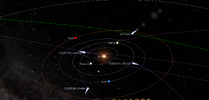At TC of the Solar Astronomy Laboratory of the Space Research Institute of the Russian Academy of Sciences mentions something interesting...Solar activity sure increased big time today! The second X-Flare of the day, this time measuring X1.1 was just detected around a new region that is hiding just off the southeast limb. It looks like we now have two active regions that could potentially provide high solar activity over the next week or so SolarHam.com
It can also be noted that the very fact of the Sun producing two consecutive X flares is quite rare. In the first quarter of the 21st century, just over 240 X-class flares have been recorded on the Sun, which means they occur on average less than once a month. This year, the last time something similar was observed was on January 3 and 4, when 3 X-level flares occurred within 24 hours. But even then, the intervals were about 10-12 hours. From this point of view, the recent event is unique at least on a yearly scale, and most likely over a longer period of time.
Comet 2024 G3 (ATLAS) was near, reached perihelion on January 13th and on January 2, increased it's brightness.
Comet C/2023 A3 (Tsuchinshan–ATLAS) reached its perihelion on September 27, 2024 and there was an X4. 5 solar flare on September 14
This two and 3I/Atlas coming from the Oort Cloud, wonder if they are kind of differently energized due to their long period trayectory.

